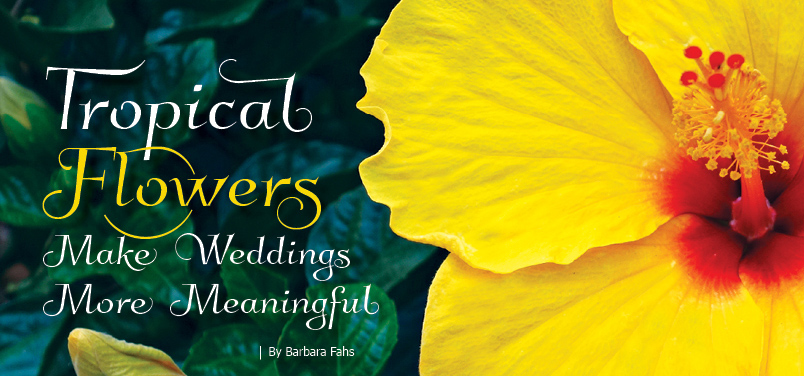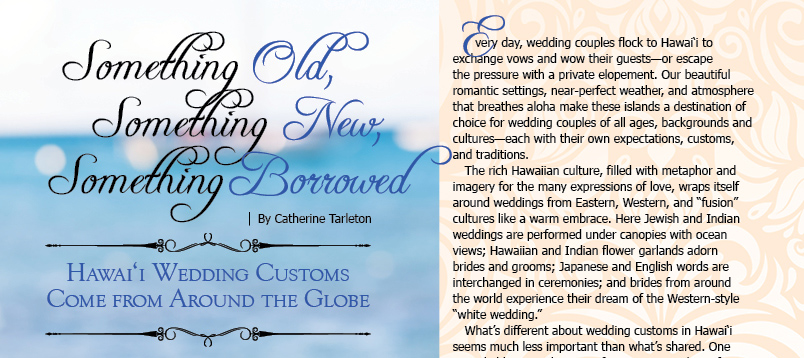
Tropical Flowers Make Weddings More Meaningful
 Each wedding has special meanings for the bride, groom, and their loved ones. It’s simple to enhance the heartfelt emotions shared by everyone who is involved by incorporating flowers with special meanings into the ceremony.
Each wedding has special meanings for the bride, groom, and their loved ones. It’s simple to enhance the heartfelt emotions shared by everyone who is involved by incorporating flowers with special meanings into the ceremony.
Hawaiian weddings open up a panorama of beautiful tropical flowers from which to choose. Other common flowers, herbs, and wildflowers can enhance the beauty of the tropical flowers you pick for your special day. As with any design, keep in mind color compatibility and tread lightly, by limiting the number of different species you choose to combine.
Anthurium
This iconic heart-shaped flower in its brilliant hues that range from white to pink to fire engine red signifies hospitality, happiness, and abundance.
Anthuriums in shades of pink and peach are popular in wedding bouquets, because they are sensational to look at and they are among the most long-lasting cut flowers.
Anthuriums also dry nicely, so for the bride who wants to keep a physical reminder of her wedding day, the anthurium flower is the perfect choice.
Bird of Paradise
The exotic purple and orange bird of paradise is related to the banana and the heliconia.
Flowers from this plant are associated with joyfulness and magnificence. Anticipation is another emotion that the bird of paradise imparts, and few other feelings are more prevalent at a wedding than this one.
A table centerpiece that includes birds of paradise will cause your guests to exclaim over their beauty. When birds of paradise are combined with other color-compatible tropical flowers such as orchids, their stunning effect is accentuated.
Gardenia
To make your wedding venue smell heavenly, include gardenias in bouquets, centerpieces, boutonnières, or flower arrangements. If you can find it, the native Tahitian tiaré (Gardenia taitensis) is especially fragrant.
Their meaning of “secret love” will cease to apply on your wedding day when you publicly declare your love for each other!
Gardenias of all types also express joy, purity, and sweetness.
For a special treat for your guests, include one gardenia blossom in a small bowl of water at each place setting in the reception hall. When combined with other fragrant flowers, such as roses, the church or reception hall will simply explode with sweet scents.
Hibiscus
The state flower of Hawai‘i is a native yellow hibiscus called the ma‘o hau hele, or Hibiscus brackenridgei.
Wouldn’t it be wonderful to include a bouquet of this endangered flower in a wedding bouquet? Just be certain that they have not been collected in the wild, so as to limit their disappearance from their native home.
Although the flowers of this hibiscus and the many cultivated species are short-lived as cut flowers, all hibiscus flowers connote “delicate beauty.”
Here’s a suggestion: because the hibiscus is traditionally worn behind the right ear to indicate that a woman is single and behind the left ear to illustrate that she is in a relationship and is not interested in a new one, the bride could walk down the aisle with a hibiscus bloom behind her right ear and switch it to her left ear as soon as she says, “I do.”
Hydrangea
The large “puffball” flower clusters of hydrangeas come in a rainbow of colors and add a soft beauty to any floral arrangement.
Symbolizing heartfelt emotions and perseverance, hydrangeas are entirely appropriate for any wedding ceremony or floral arrangement at the reception that follows.
The shrub on which these flowers grow prefers a cooler climate and thrives at the higher elevations; most florists will be able to provide lovely fresh hydrangeas.
Like anthuriums, hydrangeas dry nicely and will keep for several years.
‘Ilima
‘Ilima (Sida fallax) is a small yellow or orange flower in the hibiscus plant family and serves as the flower of O‘ahu.
Ancient Hawaiians cultivated ‘ilima for its flowers because an ‘ilima lei requires at least 700 blossoms.
NativePlants.Hawaii.edu reports, “Though lei ‘ilima was associated with royalty at one time, today anyone can wear this very special and beautiful lei.” Because you are Queen for the Day, the ‘ilima might be the perfect lei for your wedding.
Iris
The many species and cultivars of iris offer a complete palette of colors and a variety of flower types.
Overall, the iris represents eloquence, which makes it especially appropriate for brides and grooms who have a gift of gab or are literary types.
Purple iris flowers symbolize wisdom; blue signifies faith and hope; yellow means passion; and white indicates purity.
For a spectacular bouquet that will also smell divine, combine purple iris blossoms with hyacinths, lilacs, and white or silver-hued roses.
‘Ōhi‘a Lehua
This familiar native tree, which produces puffy flowers in red, yellow, orange, or white, represents both male and female elements—the wood signifies male and the flower female.
‘Ōhi‘a lehua blossoms are sacred to the goddess Hi‘iaka, who was the guardian of this tree.
Hawai‘i state law prohibits picking the flowers in state parks without special permission.
NOTE: Ceratocystis fimbriata, a fungus known now as ‘ōhi‘a wilt, has been killing ‘ōhi‘a trees on the Hawai‘i Island for the past five years. Mahalo for using other flowers for your special day.
Orchids
Here on the Orchid Isle, it would seem a shame to overlook some of the beautiful members of the largest family of flowering plants.
All of the many varieties of orchids express exotic beauty, refinement, thoughtfulness, and mature charm. If those terms resonate with you and your partner, orchids will be a superb addition to your wedding.
From the “moth orchid” (Phalaenopsis) to the splashy “corsage orchid” (Cattleya), members of this family blend nicely with many other flowers and will add tropical beauty to any lei, bouquet, or arrangement.
Passion flower
As you might expect, the passion flower exemplifies passion.
It also evokes the Passion of Christ from the time of the Last Supper until His death, so this religious symbolism is appropriate for church weddings of the faithful.
In Japan, the passionflower has special meaning as the “clock plant,” due to its round shape.
Plumeria
For many people, the scent of plumeria blossoms triggers memories and fantasies of the Hawaiian Islands. Few flowers signify the Hawaiian Islands like plumeria.
The different species and cultivars of plumeria sport highly fragrant flowers that are up to two inches in diameter and are frequently used in lei.
Colors range from white to pink to orange and bi-colored to vibrant crimson.
These flowers symbolize perfection, springtime, and new beginnings, making them appropriate for a wedding in April or May.
Protea
Growing at higher elevations on the leeward side of Hawai‘i Island, the stunning, prehistoric-looking proteas might be mistaken for artificial flowers. In fact, proteas are thought to possibly be one of the oldest flowers on Earth.
Named after the Greek god Proteus, their meanings of change, transformation, and courage certainly apply to taking the leap to a new life with your partner.
Many protea blooms are quite large, so combine one or two that you especially like as a feature flower with smaller flowers such as roses and baby’s breath in your bouquet to make an interesting statement.
Depending on your color theme, consider some of the smaller proteas for centerpieces and flower arrangements.
In addition to their beauty and symbolism, proteas can be dried for a long-term remembrance of that special day.
Roses
Common nursery flowers in all climate zones; fragrant roses grow beautifully in our tropical climate zone and symbolize love.
Different colors and quantities of roses have varying meanings: for example, pink roses indicate admiration and appreciation; red roses signify passionate love; red and white roses signal unity; white roses mean purity; and yellow roses are used to express friendship.
When 50 roses are combined, they express unconditional love.
By evaluating your emotions, you can easily choose just the right rose for your wedding and reception.
Torch Ginger
The flashy red torch ginger is frequently included in tropical floral arrangements. Because they are large, they are most appropriate for such displays rather than bouquets.
Torch ginger represents diversity and limitless wealth, two attributes all marriages can appreciate.
Herbs
Herb flowers are sometimes smaller and less conspicuous than the flashy tropical flowers you might choose to include in the décor, corsages, bouquets, and boutonnières that make a wedding special and gorgeous.
Herb flowers smell heavenly and share a long history and folklore of many meanings.
Here Are a Few Beauties
✿ The tiny, highly fragrant lavender colored flowers of rosemary signify remembrance. Rosemary can be used to honor a departed grandparent or another loved one who is unable to attend the nuptials.
✿ Lavender spikes combined into a bouquet are beautiful as well as fragrant. All of the 28 species of lavender connote purity, silence, devotion, and virtue.
✿ Angelica plants sport clusters of small, greenish-white lacy flowers, similar to baby’s breath. This herb symbolizes inspiration.
✿ The flower spikes of some basil species, such as Thai basil and Tulsi, occur in lovely shades of lavender to purple and have strong yet pleasing scents. In addition to the healing properties of some varieties, the basils represent good wishes.
✿ Heliotrope is another herb whose flowers have a heavenly fragrance. It represents eternal love.
✿ Sage is for far more than turkey stuffing. This pleasant-smelling herb signifies wisdom and immortality, while the red-flowered varieties say “forever mine.” In addition to the common culinary sage (Salvia officinalis), up to 1000 species exist in the Salvia genus, such as Clary sage, blue sage, tri-color sage, “Red Hot Sally” scarlet sage, Victoria blue salvia, and others in the largest genus of the Lamiaceae family.
✿ Violets are tiny blue to purple flowers that have medicinal qualities in addition to imparting a meaning of delicate love, loyalty, devotion, and faithfulness. Violets are the flower of the month for February, so are especially nice for late winter weddings. They can also be used to make attractive boutonnières for the groom and groomsmen.
✿ Yarrow is a pretty medicinal wildflower with heads of tiny flowers that together form a “shield.” It symbolizes everlasting love.
Other Common Flowers
For a homespun touch, some of the following wildflowers and common garden plants can add simple beauty and additional meaning to a wedding:
✿ Honeysuckle flowers smell wonderful and taste even better. Their flowers represent the bonds of love.
✿ Hyacinth is a bulb that develops tall flower spikes in shades of purple, pink, white, and blue. Their scent is almost narcotic and they signal the constancy of love and fertility.
✿ White jasmine imparts the feeling of sweet love. Our Hawaiian pīkake, or Jasminum sambac, has tiny white flowers with a pleasant jasmine scent. These flowers are often included in lei to celebrate Lei Day on May 1.
✿ Young brides and grooms might enjoy using purple lilacs in their wedding décor because these fragrant flowers indicate the joy of youth.
✿ Sweet peas are a common garden flower that blooms in spring. Their name describes their scent: sweet. They connote pleasure.
✿ Although zinnias are a common plant, they survive well as cut flowers and sport flashy-colored blooms. They represent thoughts of absent friends, whom some brides and grooms might want to acknowledge. ❖
Photos courtesy Forest and Kim Starr
Contact writer Barbara Fahs
Sources
Almanac.com/content/meaning-flowers
DavesGarden.com/guides/pf/go/170
FlyAwayBride.com/proteas-in-wedding
GardenGuides.com/82340-meaning-violet-flowers.html
LiveStrong.com/article/129125-meaning-lavender-flowers
NativePlants.hawaii.edu/plant/view/Sida_fallax
PassionFlowerBasket.com/passion-flower-name.html
TheFlowerExpert.com/content/aboutflowers/flower-meanings
Wikipedia.org/wiki/List_of_Salvia_species


